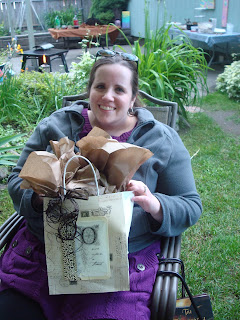Before this month’s meeting several of you had
given way to the idea that I had completely lost my marbles, due to the
homework assignment. Sadly I think it led to a smaller turn out, however for
those of us that did participate in my many strange but fun activities we
decided that even though my assignments seem totally nuts they do make for a
fun evening!!!
For her participation, investigative deduction and cleverness
Anna was awarded this month’s bag of goodies. She had us all laughing at her
many kitchen item clues!! My personal favorite was the bottle of hot sauce she
used to represent Mexico!!
For those of you that are curious the answers to
our 12 clue quest were as follows:
Clue
#1In which previous book club book did a thirty year old secretary, decide to take a yearlong adventure of recreating 524 French recipes? ~Julie and Julia
― Diane Setterfield, The Thirteenth Tale
Several of us agreed with this quote and said we constantly
found ourselves hypnotized by the passages in this story. We also agreed that
the book would have been better had it ended about 30 pages before it did. The
nice little wrapped up ending wasn’t needed and it felt amateur when compared
to the other wonderful charms that book laid before us.
For many of us we saw certain sections of the book
going very differently. For the most part Anna and Marsela said they had
figured the ending out. They knew that our beloved Ms. Winter was in fact not
one of the twins. Sarah on the other hand had her pegged as a schizophrenic with definite
split personalities and both Beth and I found ourselves wondering several times
whether or not there had ever been twins to begin with or if it had always just
been one person. I admittedly said I didn’t see the ending coming.
In the end we all voted the book needed to be
ranked among the other brilliant stories from our book club past. It has now found
a home among our top five.
Before leaving I passed out the cute little
patriotic inspired pin wheel invitations for July’s meeting and gave everyone
very strict instructions that if they wanted to win this month’s prize they
would need to pull out all the stops with their best red, white and blue
outfits!!
We had a blast at the meeting and left feeling
excited for what next month had in store for us. I personally am very excited
to see what everyone comes up with for our next meeting and to hear their
opinions of the book An American Childhood.
So until next time as usual Happy Reading!!!
Sincerely yours,
Mistress Book Club Wench














